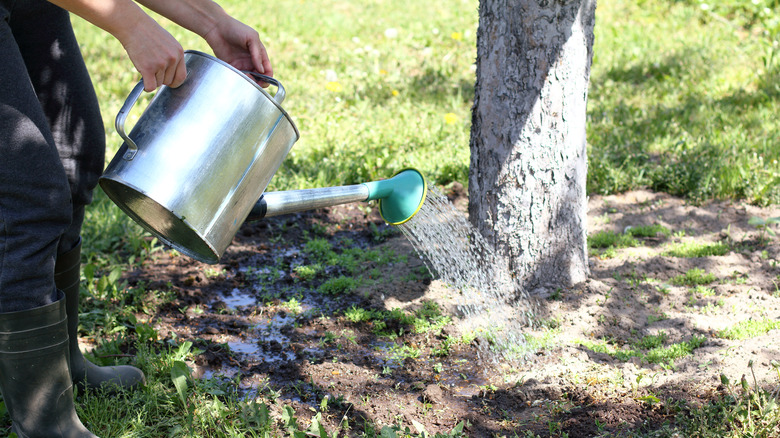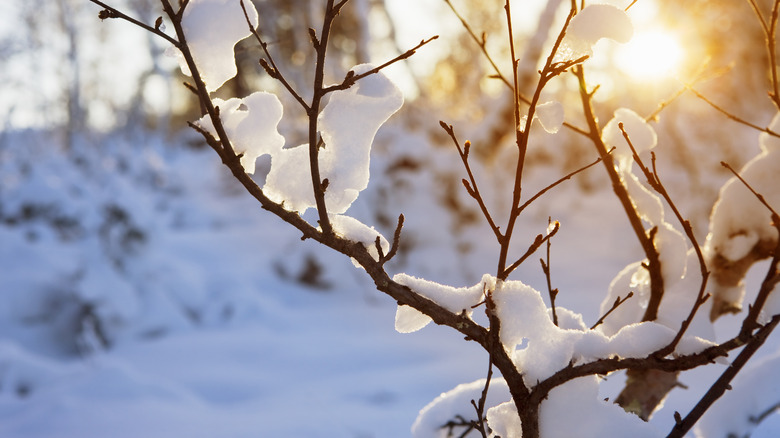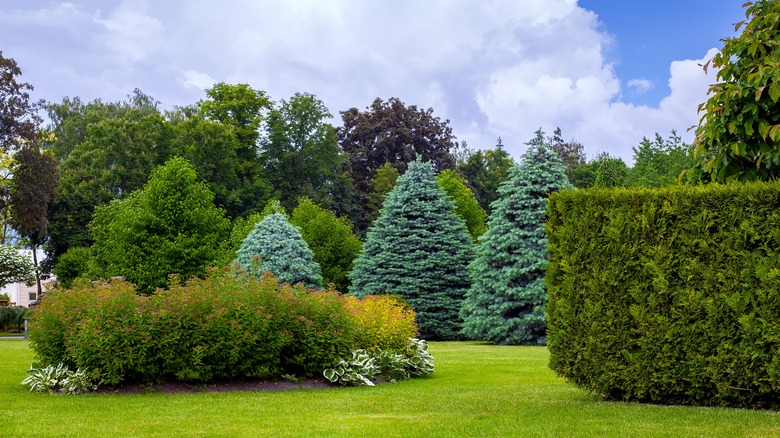Why You Shouldn't Forget To Water Your Trees In The Winter
During the winter season, the air gets crisper and more robust when it blows, making everything it touches a little dry. While we might care for ourselves as best we can, it's also vital to care for our yard during the colder months too. Trees, for instance, lose all their leaves by the time winter rolls around, but they still need water to get them through the season. Even though they won't produce foliage immediately, small amounts of water can help prepare them for springtime. Trees lose a lot of moisture during the winter due to strong winds and various temperature changes. It takes them some time to adjust, so they need a little help.
Many trees and shrubs are dormant in winter, but their roots remain active. If their roots don't receive enough water to keep them hydrated, they can suffer from root damage, affecting them when they try to bloom again in the spring. The harsh, cold weather lasts from October to March, putting them at risk of drying out. Of course, your tree's watering needs will depend on your location, tree, and soil type. Newly planted and transplanted trees will need more water than established trees. If you live somewhere with a snowy or icy climate, you won't need to water as often as someone who lives in a sunnier area. And, watering your trees when the weather is above 40 degrees Fahrenheit is best so that your trees can reap all the benefits.
Watering your trees protects them from freezing
Trees require insulation around their roots from the soil to stay moist. However, when the soil gets dry and cold, it loses its insulation capabilities, which causes it to freeze faster. The surface-level roots that send the water and nutrients to the deeper roots can die when the soil freezes, cutting off the nourishment that the trees need during winter. For the soil to stay insulated, it needs water to continue hydrating the roots. When snow or ice covers the soil's surface, it adds a protective layer of insulation, but it doesn't allow you to water the trees or shrubs because there isn't an opening for any liquid to enter.
You might think the ice and snow that layers over the surface can water the trees, but even though snow and ice turn into water when they melt, there's not enough water for the trees to consume. Plus, the amount of melted snow available is reduced when it's shoveled by homeowners or blown away by the wind. The downside to winds blowing away snow is they remove the insulation blanket over the soil, which puts it at risk of freezing and harming the tree's entire internal system. Add a layer of mulch around your trees before the snow falls to ensure the soil stays protected. Moreover, if the soil dries out or freezes, the decomposition slows down, and the soil organisms that break down organic matter can die or move to other hydrated soils.
A little water keeps trees hydrated and prepares them for spring
Trees are easily prone to getting dehydrated in the winter. According to Kathy Glassey, arborist and senior consultant at Inspire Green, the tree's tissues can dry out from insufficient water in the winter (via The Handy Man). Evergreens are more susceptible to desiccate tissues because they typically release water vapor through their pores, so when they're not watered, there isn't anything to replace the moisture loss as they exhale the water vapor.
Watering your trees will ensure they stay hydrated. Even though they absorb the water and nutrients slower, "The water they store in their roots during winter becomes vital for leafing out with new growth once everything warms up," Glassey says. If you tend to get snow where you live, preparing your trees for the snowy weather is essential. For instance, if you notice brown needles on your tree and expect snowfall, you'll only need to water your tree a couple of times before the snow arrives. The snow will insulate the soil, keeping it moist and your tree hydrated. However, if you're not expecting any snowfall or icy weather, water your tree if you notice the soil drying out and if there's warmer weather. Watering will vary, so you don't have to worry about watering your trees every week. Paying attention to the weather and soil level will tell you when your trees need water so you don't overwater them.


